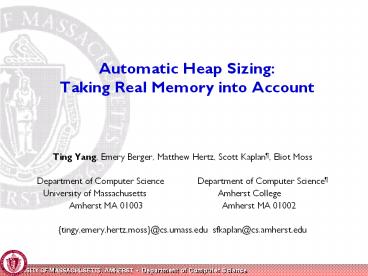Automatic Heap Sizing: Taking Real Memory into Account - PowerPoint PPT Presentation
1 / 22
Title:
Automatic Heap Sizing: Taking Real Memory into Account
Description:
Automatic Heap Sizing: Taking Real Memory into Account Ting Yang, Emery Berger, Matthew Hertz, Scott Kaplan , Eliot Moss Department of Computer Science ... – PowerPoint PPT presentation
Number of Views:107
Avg rating:3.0/5.0
Title: Automatic Heap Sizing: Taking Real Memory into Account
1
Automatic Heap SizingTaking Real Memory into
Account
- Ting Yang, Emery Berger, Matthew Hertz, Scott
Kaplan, Eliot Moss - Department of Computer Science
Department of Computer Science - University of Massachusetts
Amherst College - Amherst MA 01003
Amherst MA 01002 - tingy,emery,hertz,moss_at_cs.umass.edu
sfkaplan_at_cs.amherst.edu
2
Problem Motivation
Too large
page a lot
Optimal
Too small
GC a lot
Heap size vs Running time
Appel _213_javac
60MB real memory
3
Problem Motivation
- Multiprogramming makes it harder
- Amount of available real memory changes
- Impossible to select heap size a priori
- Strategy adjust adaptively during execution
4
Outline
- Problem Motivation
- Paging behavior of Garbage Collection
- VMM collecting the information we need
- Collector adjusting heap size adaptively
- Experimental results
- Conclusion Future work
5
GC Paging Behavior
- For strategy to work, need to relate
- GC algorithm, heap size, and footprint
- Analysis methodology
- Obtain reference trace simulate Jikes RVM under
DSS - Process with LRU stack ? faults at all memory
sizes - GCs and programs traced
- Mark-Sweep (MS), Semi-Space (SS), and Appel GCs
- SPECjvm98, ipsixql, and pseudojbb benchmarks
6
Heap size
extreme paging
substantial paging looping behavior
50 seconds
fits into memory
of Faults 1000
Heap Size 240Mb
0.5 second
Memory 145Mb
Fault curve Relationship of heap size, real
memory page faults
7
Page fault threshold
Our definition of footprint The amount of
memory needed so that the time spent on page
faults is lower than a certain percentage of
total execution time
Relationship between heap size and footprint
8
A Linear ModelHeap size vs. Footprint
- Heap footprint model
- Heaputil SS 0.5 MS 1
- base Jikes RVM plus live data size
- How the GC can use this model
9
Strategy Overview
- Garbage Collector (in User Space)
- Has ability to change heap size
- Needs info available memory, footprint
Request
Send
mem alloc
mem alloc
footprint
footprint
- VMM ( in OS)
- Knows memory allocation / available memory
- Needs to track/calculate application footprint
10
Outline
- Problem Motivation
- Paging behavior of Garbage Collection
- VMM collecting the information we need
- Collector adjusting heap size adaptively
- Experimental results
- Conclusion Future work
11
Approach to Measuring Footprint
Memory reference sequence
LRU Queue Pages in Least Recently Used order
1
14
Hit Histogram
Associated with each LRU position
5
1
Fault Curve
1
14
11
4
12 pages
5 pages
12
VMM design SegQ SKW99,KMC02
Strict LRU
CLOCK algorithm
LRU Queue
Hot set
Cold set
Evicted set
Major fault (on disk)
Minor fault (in memory)
Hit Histogram
Footprint
Hot / Cold Boundary
- Decay histogram periodically
- Adaptive control of hot set size
13
VMM design SegQ SKW99,KMC02
Strict LRU
CLOCK algorithm
Hot set
Cold set
Evicted set
Footprint
Hot / Cold Boundary
What is the footprint w.r.t 5?
14
Outline
- Problem Motivation
- Paging behavior of Garbage Collection
- VMM collecting the information we need
- Collector adjusting heap size adaptively
- Experimental results
- Conclusion Future work
15
Collector Design
- Communicate with VMM after GC
- First GC
- Appel, SS HeapUtil 0.5
- Following GCs
- Calculate HeapUtil from history
16
Outline
- Problem Motivation
- Paging behavior of Garbage Collection
- VMM collecting the information we need
- Collector adjusting heap size adaptively
- Experimental results
- Conclusion Future work
17
Experiments
- Experimental setting Jikes RVM 2.0.3
- Dynamic SimpleScalar extended with new VMM model
- Major fault 5 million instructions 5 ms _at_ 1
Gips - Minor fault 2000 instructions 2 µs
- Page fault cost threshold 5 - 10
- Histogram collecting cost threshold 1
- Adapting to fixed memory pressure
- Adapting to dynamic memory pressure
- Add/Remove 15MB real memory after 2 billion insts
18
Paging a lot
Larger heap Fewer GCs Less Paging
Memory under-utilized
Optimal heap
19
(No Transcript)
20
(No Transcript)
21
Conclusion Automatic Heap Sizing
- New collector usually picks heap size that
- Maximizes memory utilization (reducing GCs)
- While avoiding paging
- Linear model works well in practice
- Improves performance by up to 8x under pressure
- Cost of collecting information is low around 1
- New collector adapts quickly to steady and to
changing real memory allocations - Within 1 or 2 major GCs
22
Ongoing Work
- Implement in real kernel
- Extend to more collectors
- Adjust during allocation, not just after GC
- Detailed graphs tech report
- http//www-ali.cs.umass.edu/tingy/CRAMM































